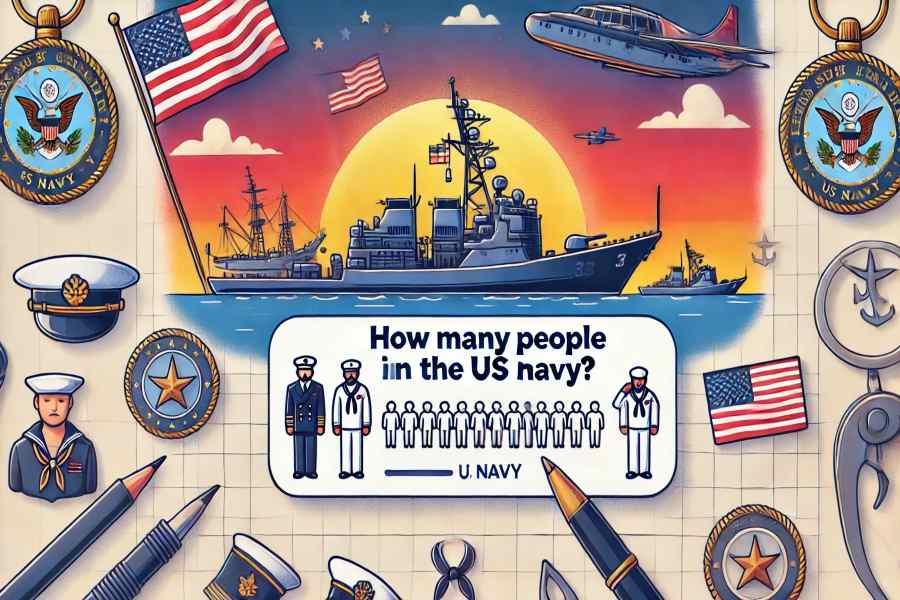
The United States Navy, one of the world’s largest and most potent maritime forces, plays a crucial role in maintaining global security and peace. Understanding the size and composition of the Navy provides valuable insights into its capabilities and operational readiness. In this comprehensive article, we will explore the current number of personnel in the US Navy, historical trends, recruitment processes, and the factors influencing its size. Whether you’re interested in military affairs, considering a career in the Navy, or simply curious about its operations, this guide will provide you with all the information you need.
How many people are in the US Navy?
The US Navy comprises approximately 346,000 active-duty personnel and 100,000 reservists. This number includes sailors in various roles, from officers to enlisted personnel, stationed worldwide. The size of the Navy can fluctuate based on recruitment, retention rates, and military needs.
The Current Size Of The US Navy
The US Navy is a significant component of the United States Armed Forces, renowned for its strategic importance and operational capabilities. As of the latest data, the Navy boasts around 346,000 active-duty personnel, including officers, enlisted sailors, and specialized units like the SEALs. Additionally, the Navy Reserve adds approximately 100,000 personnel to the total force.
The Navy’s composition is diverse, with individuals serving in various capacities. Each role is vital for the Navy’s overall mission, from submarine crews to aircraft carrier personnel. The Navy’s size is influenced by several factors, including recruitment rates, retention policies, and budget allocations. In recent years, efforts have been made to enhance recruitment strategies, focusing on attracting highly skilled individuals.
Retention is another critical aspect that affects the Navy’s size. Programs to retain experienced personnel have been implemented to improve career satisfaction and opportunities for advancement. These efforts ensure the Navy maintains a balanced mix of seasoned veterans and recruits.
In terms of geographical distribution, the US Navy has personnel stationed around the world. Major naval bases are in strategic locations such as Norfolk, Virginia; San Diego, California; and Pearl Harbor, Hawaii. Additionally, numerous smaller installations and ships have been deployed globally to maintain a constant presence and readiness.
Understanding the Navy’s current size is crucial for assessing its operational capabilities. The number of personnel directly impacts the Navy’s ability to carry out missions, respond to emergencies, and maintain global security. Continuous monitoring and adjustments are necessary to align the Navy’s size with national defense needs.
Historical Trends In Navy Personnel Numbers
World War II Era: During World War II, the US Navy experienced a massive expansion, reaching over 3 million personnel at its peak. This was necessary to support the extensive naval operations across the Atlantic and Pacific theaters.
Cold War Period: Post-World War II, the size of the Navy fluctuated, and geopolitical tensions during the Cold War influenced it. The personnel generally ranged between 500,000 and 600,000, with peaks during the Korean and Vietnam Wars.
Post-Cold War Reductions: At the end of the Cold War, the Navy significantly reduced its personnel, reflecting broader military downsizing. By the early 2000s, the number had decreased to around 375,000.
21st Century Adjustments: In the 21st century, the Navy’s size has remained relatively stable, with minor fluctuations in response to operational demands and budgetary constraints. The current focus is on maintaining a lean but capable force.
Recent Trends: In recent years, efforts have been made to slightly increase the size of the Navy to meet modern challenges, such as cyber warfare and increasing maritime threats. Recruitment and retention initiatives have been key to these efforts.
Impact Of Technological Advancements On Navy Personnel
Technological advancements have profoundly transformed the composition and operations of the US Navy. These changes encompass various aspects, from automation and robotics to advanced training programs and improved communication systems, fundamentally altering how the Navy functions and utilizes its personnel.
Automation and Robotics:
Integrating automation and robotics within the Navy has significantly reduced the need for manual and repetitive tasks, enabling personnel to focus on more complex and strategic roles. For example, unmanned vehicles and drones are increasingly used for reconnaissance and surveillance missions, reducing the risk to human life and enhancing the efficiency of operations. This shift allows sailors to engage in tasks that require critical thinking and decision-making, thus elevating the overall skill level within the Navy.
Cyber Warfare:
The emergence of cyber warfare as a critical domain has necessitated the creation of specialized roles focused on cyber defense and operations. Navy personnel are now required to develop skills in cybersecurity, protecting sensitive information and critical infrastructure from cyber threats. This development has led to the establishment of dedicated cyber units, where sailors are trained in advanced cyber tactics and strategies, reflecting the increasing importance of digital security in modern naval operations.
Advanced Training Programs:
Technological advancements have revolutionized Navy training programs. Simulators and virtual reality (VR) technologies provide realistic training environments where sailors can practice complex maneuvers and respond to various scenarios without the risks associated with real-life exercises. These advanced training tools enhance the preparedness and proficiency of Navy personnel, ensuring they are equipped to handle the demands of modern warfare and operations.
Improved Communication Systems:
Enhanced communication systems have improved coordination and efficiency within the Navy. Advanced satellite communications, secure data links, and real-time information-sharing capabilities allow for better management of personnel and resources. This improvement ensures that Navy operations are conducted smoothly and effectively, with precise coordination between different units and command structures, thus optimizing mission success and operational readiness.
Technological Proficiency:
Navy personnel must continuously update their skills and knowledge to stay abreast of the latest advancements as technology evolves. This ongoing education and training ensure that the Navy maintains a technologically proficient force capable of leveraging new tools and systems to their fullest potential. Continuous professional development programs and access to cutting-edge technologies enable sailors to remain at the forefront of technological innovation.
Operational Efficiency:
The Navy’s overall operational efficiency has seen significant improvements due to technological advancements. Technology has enabled the Navy to operate more effectively and efficiently, from streamlined logistics and supply chain management to enhanced maintenance and repair processes. These improvements contribute to the Navy’s ability to sustain long-term operations and maintain a high state of readiness.
Conclusion
With its vast number of active-duty personnel and reservists, the US Navy remains a cornerstone of American military strength. Understanding the Navy’s size, composition, and dynamics provides valuable insights into its operational capabilities and strategic importance. As the Navy continues to evolve, adapting to new challenges and technological advancements, it remains committed to maintaining its readiness and effectiveness in safeguarding national and global security.
FAQ’s
Q. What kind of training do Navy recruits undergo?
A. Navy recruits undergo basic training at the Great Lakes Naval Training Center, followed by specialized training based on their designated roles.
Q. How has technology impacted the Navy?
A. Technology has significantly impacted the Navy, creating new roles, enhanced training programs, and improved communication and operational efficiency.
Q. What are the demographics of the US Navy?
A. The Navy’s personnel are diverse, with increasing numbers of women, a wide age range, varied educational backgrounds, and growing ethnic diversity.





